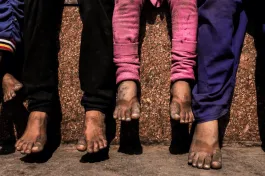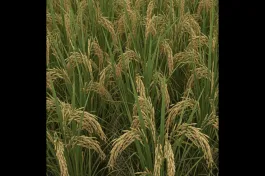For 25 years, a few Jatt Sikh households in Maujo Kalan village in Punjab’s Mansa district had not allowed a Dalit family to open the main gate of their house to access the street. The dominant caste households had erected a cement platform in front of the gate and placed an idol of Hanuman on it.
As dawn broke on 24 December 2021, activists from unions of agricultural labourers unions, farmers and students assembled in front of the house of the Dalit family, determined to demolish the platform. As cultural activists inspired the gathering through revolutionary songs, officials from the local administration and police came to negotiate with the protesters. The activists reminded the officials of their constitutional responsibility to act against caste oppression, but the officials were unwilling to raze the platform.
Finally, towards the evening, the protestors took up hammers and demolished the structure, except the part on which the idol was kept.
Uncharacteristically, one of the supporters of the agitation was Rajdeep Kaur, the Jatt Sikh woman sarpanch of the village. Kaur subsequently was boycotted by members of her community. Panchayat members put impediments to her official activities and tried to implicate her in false corruption charges. Faced with such harassments, a year later, she attempted to die by suicide, but timely medical treatment saved her life.
Struggles initiated by rural labourers’ unions witnessed either the formation of joint fronts or outside support from non-Dalit organisations.
At Kaur's extreme step, activists and unions who participated in the earlier struggle formed a sanjha morcha (joint front), the Action Committee for Justice for Sarpanch Rajdeep Kaur. Even though Kaur belonged to a dominant caste family, they articulated the fight for justice for her as an anticaste struggle. A victory for her would also defeat those who oppressed the Dalit family. The agitation to force the police to file charges and arrest the accused, which began in December 2022 is still continuing.
The significant development in both these protests was the formation of the sanjha morcha comprising Dalits and non-Dalits. The morcha was not the first of its kind In the recent past, struggles initiated by rural labourers’ unions witnessed either the formation of joint fronts or outside support from non-Dalit organisations, especially kisan unions. The participation of the socially and economically dominant Jatt-Sikhs through such sanjha morchas influences the course of struggle against caste oppression in a state where one-third of the population is Dalit.
Yet, such involvement confines protests to resolving specific cases of atrocity against Dalits, ultimately failing to contest the role of landed Jatt-Sikhs in maintaining the caste structure. The Maujo Kalan protests throw light on these limitations.
The making of a united front
The campaign for road access began in July 2021 when Bahal Singh, an agricultural labour union activist visited the village. He urged farmers’ unions to join the struggle to go beyond the rhetoric of the much-talked-about kisan-mazdoor ekta (unity between farmers and labourers). The hostility towards opening the gate, according to him, was a hindrance to this ekta. In response, Darshan Singh of the Krantikari Kisan Union (KKU) participated in the struggle. Singh said that despite him belonging to a “kisan parivar” (farmers’ family), he could not tolerate injustice (dhakka) meted out to a poor family.
These statements echoed the narrative of kisan-mazdoor ekta during the year-long farmers’ protest at the Delhi border in 2021, which was glorified as the emergence of cross-caste unity.
A few other farmers’ unions too took up the call to strengthen kisan-mazdoor ekta by participating in the struggle. These statements echoed the narrative of kisan-mazdoor ekta during the year-long farmers’ protest at the Delhi border in 2021, which was glorified as the emergence of cross-caste unity. These efforts resulted in the formation of a sanjha morcha, which consisted of representatives from agricultural labourers’ and farmers’ unions, and from the Association for Democratic Rights, Punjab.
In the case of agricultural labourers’ unions, the appeal for ‘ekta’ has another dimension. Rural Dalits have a tactical disadvantage. They are in a weak position to mobilise human and financial resources and sustain protracted struggles. It is a challenge to bring daily wage labourers to protest sites, or to force the local administration and the state government to accept their demands. Landowning Jatt-Sikhs, who are the perpetrators of exploitation against Dalits in a majority of incidents, are politically, economically, and numerically stronger and a more cohesive caste group despite internal class divisions based on ownership of land.
To overcome this disadvantage, rural Dalits need to perform twin tasks to effectively protest: mobilise large numbers including non-Dalits, and minimise the opposition within their village. This is possible only if a section of Jatt-Sikhs supports their struggle, or at the very least, not oppose them and remain ‘neutral’.
The response of these kisan unions are very crucial due to their organisational strength and capacity to fight prolonged struggles.
It thus becomes a pre-requisite for agricultural labour unions to approach various other organisations. The farmers’ unions are one amongst the first to be approached. The response of these kisan unions are very crucial due to their organisational strength and capacity to fight prolonged struggles. Therefore, there is a boost of confidence amongst the aggrieved family or community when farmers’ unions join a protest.
Reaching across
Under these circumstances, how do the activists of agricultural labourers’ unions appeal to the farmers unions dominated by Jatt-Sikhs?
An activist of an agricultural labourers’ union told me that during his first public address he condemned Jatt-Sikhs for creating hurdles in acquiring village common land for landless Dalits. After the speech, a marginal Jatt-Sikh farmer came to him and complained. “We have come to your support and you are abusing us. This is not the right approach.” The speech had made him very uncomfortable and he was contemplated disassociating himself from this protest.
This incident highlighted the role played by the Jatt-Sikh community in perpetuating graded inequality by forcefully keeping Dalits landless. Yet, agricultural labourers’ unions are forced to seek solidarity from these non-Dalit sections and unions. Their withdrawal from the protest would adversely impact the immediate goals which the protests strive to achieve. But why would they support the struggles waged by Dalits which “vilified” them?
It is usually only left-leaning farm unions that make efforts to participate in these protests. One of the significant reasons for this support is their theoretical and ideological understanding. They consider India as a semi-feudal country and the class alliance or joint front between landless rural Dalit agricultural labourers and marginal and poor peasantry is the key to march forward on the path of socialist revolution. They adhere to the thesis of Mao-Tse-Tung that the peasantry should not be considered as a homogenous mass. It comprises internal class differentiations on the basis of ownership of size of land holdings. Efforts must be placed to sharpen these internal class contradictions amongst peasantry and reduce the strength of landlords and rich peasants in rural areas. The challenge for leadership of these unions is to convince their dominant-caste cadre to participate in the struggle of Dalits, against whom the farmers often remain conflicted due to issues of wages and of upward social mobility.
Non-left farmers’ unions sometimes oppose labourers’ protests and make the task more difficult for the rural Dalits. For instance, the BKU (Sidhupur), who was part of the 2021 farmers’ protests, stood against the struggle at Maujo Kalan village.
Walking a fine line
For rural Dalit, the possibility of counter-mobilisation by Jatt-Sikhs hangs like the sword of Damocles over them.
The protests tried to ‘awaken’ the moral conscience of Jatt-Sikhs by invoking the anticaste character of Sikhism.
Therefore, the narrative that emerged out of the protest in Maujo Kalan centred on four premises. The leadership condemned only those Jatt-Sikh families who were involved in the issue, reducing the practice of caste to its brutal manifestation, and ignoring its everyday subtle expressions. It denounced local institutions and police for spreading casteism by not responding to the demands of the protests for social and economic justices. It urged broader unity amongst various sections of society, emphasising kisan-mazdoor ekta. Finally, the protests tried to ‘awaken’ the moral conscience of Jatt-Sikhs by invoking the anticaste character of Sikhism.
The word ‘Jatt’, which comes up quite often in conversations amongst Dalit masses, found little mention in this narrative discourse. The culprits were ascribed as dhanad (rich) and chaudhary (exercising social power), and as ‘enjoying’ political power. These terms have emerged as acceptable, because the majority of the Jatt-Sikh, despite sharing a caste identity do not belong to this rich class of peasants. These epithets are repeated protest after protest, irrespective of the fact that in a number of cases the offenders are marginal and poor Jatt-Sikh farmers. In this way, the majority of dominant caste was absolved from sharing the blame of practising caste in everyday life.
Speakers invoked the Indian Constitution’s notion of equality and non-discrimination on the basis of caste. They called on institutions to protect Dalits from discrimination and atrocities by dominant castes. Ambedkar was mentioned in this articulation, but merely as a footnote.
Rather, the anticaste character of Sikhism was invoked. The activists argued that those who practice caste discrimination were not true Sikhs and went against the philosophy of equality propagated by the Sikh Gurus. The stories of the Gurus fighting for the cause of down-trodden were narrated at the protests. Darshan Singh of KKU, stated that he would stand by Guru Gobind Singh’s instruction to fearlessly fight for the right cause. Others recited verses from the Guru Granth Sahib composed by religious and anti-caste reformers. The history of Sufism, anti-caste Bhakti movement, Sikhism, and the sacrifices of revolutionaries like Bhagat Singh were summoned up to mobilise masses across caste configurations and provide moral strength to the protesters.
Not a conclusion
What these formations failed to create was a public discourse of the everyday of caste humiliation of Dalits by the Jatt-Sikh community and the role it plays in maintaining caste-based social stratification. The narration of the history of exploitation and oppression of agricultural labourers was largely missing from public speeches. The dominant narrative of these protests also centred around ekta and moral conscience, but the focus remained on unity with Jatt-Sikhs. They hardly articulate the need for unity amongst the various Dalit communities to emerge as a formidable force against caste oppression. This, despite the fact that caste divisions within Dalits act as a hindrance in their emergence as formidable force.
The history of exploitation and oppression of agricultural labourers was largely missing from public speeches.
The protests did not foreground the fact that the majority of the dominant social group believes and justifies caste hierarchy and the ‘inferior’ status of Dalits. The discourse emerging in these protests indicates that the leadership of agricultural labourers’ unions and Dalit activists have constrained themselves from discussing caste at length. The presence of socially and economically dominant Jatt-Sikhs in sanjha morchas have undermined the autonomy of Dalit labourers. Until the leadership overcomes this limitation, it is unlikely that Punjab will witness a militant anticaste movement.
Jatinder Singh is an assistant professor in the Department of Political Science, Punjabi University, Patiala.









